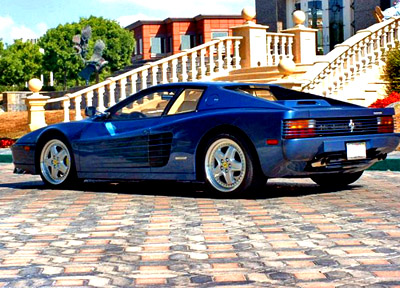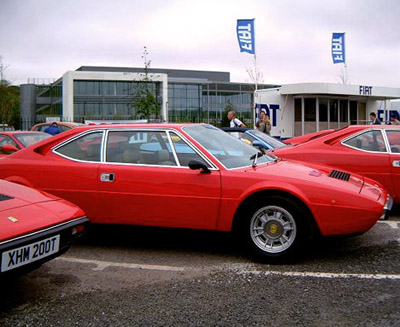|

Ferrari Prices:
Real or Imagined Gains?
CLASSIC
COLLECTOR
By Erik Nielsen
|
If you've paid
any attention to the Ferrari market lately, you'll have noticed
that prices for the most part are on the rise, dramatically in
some cases. Blue chip "investments" have been sneaking up for
years and some of the later vintage cars, like the 330 GTC, 275
GTB and Daytonas are starting to follow suit. All of them have
seen asking prices jump almost 30% in the last six months. Are the
unloved generation cars far behind?
The first thing that most people need to be reminded of when
dealing with old Ferraris is that this is not a "smart" place to
put your money. There are plenty of other investments that will
fetch much better returns and not require maintenance, insurance
and putting up with a spouse that constantly reminds you that you
don't have space to get yet one more. The second reminder is that
Ferraris need to be valued based largely on three factors: 1)
condition, 2) condition, and 3) condition. Buying a project
car without doing the math first could create even more tension
with the aforementioned spouse.
 Property
prices across the country have been rising dramatically. I won't
get into whether or not this is a good thing, but the trend seems
to be such that there are so many people flush with cash due to
interest-only mortgages or from cashing out by selling real
estate. What is important is that there are buyers in the market.
Or are there? Property
prices across the country have been rising dramatically. I won't
get into whether or not this is a good thing, but the trend seems
to be such that there are so many people flush with cash due to
interest-only mortgages or from cashing out by selling real
estate. What is important is that there are buyers in the market.
Or are there?
Going back to Econ 101 (fortunately, a class in which most
potential and current Ferrari owners did pay attention and, thus,
have since built up the appropriate slush fund from not being
fiscally stupid), buyers need to realize that supply in this case
can be limited, driving up prices. Ferrari isn't cranking out any
more 308s, Mondials, Testarossas or 400is than are already out
there and, these things being cars, the supply is constantly
decreasing. Wrecks are written off by insurance companies not
willing to pay the cost associated with bringing them back to life
and a number of project cars continue to deteriorate in a back
shed or under a tarp in the garage, impossible to be brought back
to road worthy condition without committing financial suicide. The
flip side of this is that there are plenty of low mileage examples
stashed away that were purchased foolishly as investments and that
could flood the market if prices for that model reach a certain
level. I, for one, would sell my Mondial 8 in a heartbeat if
asking prices went above $35k, but my guess is that my kids will
probably inherit it first... and there aren't even any rug rats
running around right now.
 So,
now that the beer in the Sakura lounge at Narita Airport has
started to kick in, let's take a look at the main Ferrari models
in the "classic" range. The best performer percentage-wise has
probably been the Dino 308 GT4. It's not uncommon to see asking
prices around $25k (with a few delusional souls trying to get over
$30k for nice examples). The Dino is a great car and pretty simple
to maintain, however, most of the cars that are coming to market
need work and you'll still be upside down if you pick up a project
car. That is, unless Uncle Phil willed it to you. Even then,
you might wonder exactly how much of a favorite you really are. So,
now that the beer in the Sakura lounge at Narita Airport has
started to kick in, let's take a look at the main Ferrari models
in the "classic" range. The best performer percentage-wise has
probably been the Dino 308 GT4. It's not uncommon to see asking
prices around $25k (with a few delusional souls trying to get over
$30k for nice examples). The Dino is a great car and pretty simple
to maintain, however, most of the cars that are coming to market
need work and you'll still be upside down if you pick up a project
car. That is, unless Uncle Phil willed it to you. Even then,
you might wonder exactly how much of a favorite you really are.
Mondials have remained more or less flat over the last two years,
a fact that isn't going to change anytime soon. Regardless of how
many times I say that I feel my 8 coupe is a better car than my
308 GTS QV, the market wants the "more sporting car" rather than
the solid GT. Prices for solid 8 coupes are above $20k now and
most t Cabriolets carry asking prices in the high $40Ks.
The 3x8 cars have also remained more or less flat. The subtle
price increases of the early cars are still more or less only
matching inflation and, therefore, nothing new. 328s
continue to bring a premium and, while some people are asking (in
my opinion) way too much for 1989 328 GTSs, there are buyers out
there that are willing to pay the premium for the modest increase
in performance and quality over the previous model years. 348s are
still depreciating and the prices will continue to come down as
the baby cheese grater finds its equilibrium point in the market.
Ah, this brings us to the 365 GT4 2+2s, 400s, 400is and 412s: the
most unloved cars to ever come out of the gates at Maranello.
Despite public opinion, however, these cars have managed to
attract a very small but dedicated lunatic fringe of enthusiasts.
In fact, rumor
 has it that my name was recently submitted to
become head the club, something that I would be proud of if it
wasn't for the fact that there is only one member. The good news
is that asking prices on these cars have started to sneak upward.
Maybe people have begun to listen? Possible, but a more
likely scenario is that the bad cars are starting to get scrapped
as owners have come to the conclusion that it is cheaper to write
the car off than try to restore it. While asking prices have gone
over $30k for all but the 412s, actual sales prices tend to be in
the mid $20Ks... and that is a merda-load of car for $25k! As
always, though, refer to the above comments regarding condition. has it that my name was recently submitted to
become head the club, something that I would be proud of if it
wasn't for the fact that there is only one member. The good news
is that asking prices on these cars have started to sneak upward.
Maybe people have begun to listen? Possible, but a more
likely scenario is that the bad cars are starting to get scrapped
as owners have come to the conclusion that it is cheaper to write
the car off than try to restore it. While asking prices have gone
over $30k for all but the 412s, actual sales prices tend to be in
the mid $20Ks... and that is a merda-load of car for $25k! As
always, though, refer to the above comments regarding condition.
Finally, let's take a look at the flagship cars. Surprisingly,
Boxer asking prices have risen approximately 15%. Yes, that looks
nice, but it's nowhere near the positive changes - either in value
or percentages - that the Daytona coupes have enjoyed. The rise in
value of the older cars has helped move the Boxers along, but it
always has been hard to find a solid BB in the USA that wasn't
either butchered in the EPA/DOT conversion or just poorly
maintained. These two facts tend to keep buyers away from a car
that I consider to be the last "raw" Ferrari experience (with the
exception of the F40, that is).
 Testarossas
are more or less still depreciating. This was and still is an
expensive car to own, maintenance-wise. While most people my age
had a poster of one on their bedroom wall as a kid, dreams are one
thing - looking at a stack of invoices is something entirely
different. There's still a premium for the later cars, especially
the F512M, but my prediction is that the market will eventually
see it as just a futzed-with design and an attempt to squeeze the
last bit out of the market before introducing the 550 Maranello.
As such, the styling will probably not be considered timeless. Testarossas
are more or less still depreciating. This was and still is an
expensive car to own, maintenance-wise. While most people my age
had a poster of one on their bedroom wall as a kid, dreams are one
thing - looking at a stack of invoices is something entirely
different. There's still a premium for the later cars, especially
the F512M, but my prediction is that the market will eventually
see it as just a futzed-with design and an attempt to squeeze the
last bit out of the market before introducing the 550 Maranello.
As such, the styling will probably not be considered timeless.
Okay, so that covers most of the cars out there. If money really
is cheap and there are buyers for the cars, why aren't the prices
higher? My take on the whole situation is that the vintage car's
time hasn't come. Look at who the biggest fans of the models are,
people in their 30s and 40s. Guess what? Those people are still
paying off their mortgages and saving up for their kids' college
educations. Something like a Ferrari hasn't really crossed their
minds yet (but getting a good deal on a Volvo or Lexus has). The
buyers right now, for the most part, are the enthusiasts that do
their homework before making a purchase. (Well, there are still
some mullet-wearers out there that are blowing their inheritance.)
If anything, the cars are cheap right now and when people realize
how much it will cost to sort a car that needs an SD2 or SD3
computer in ten years, the prices are going to go up. After all,
what's the point of spending money on a newer Ferrari when you
can't even get it started?
Well, they just announced my flight. Until next month…
Cheers,
Erik Nielsen,
Narita International Airport
Narita, Japan

|
|
|